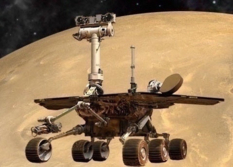A.J.S. Rayl • Apr 04, 2017
Mars Exploration Rovers Update: Opportunity Dodges Dust Storms, Makes Tracks to Perseverance Valley
Sols 4658 - 4687
After wrapping the final science investigations on the slopes of Cape Tribulation, Opportunity climbed up and over the rim of Endeavour Crater in March and embarked on the journey south toward the next, much anticipated science attraction in the overland expedition of the Mars Exploration Rovers (MER) mission, an ancient gully the team named Perseverance Valley.
“Right now we are in the business of making wheel tracks and that's what we're going to be doing until we get to Perseverance Valley,” said MER Principal Investigator Steve Squyres, of Cornell University.
Although the ancient site is located just about a half-mile away inside the western rim of Endeavour at Cape Byron, the veteran robot field geologist exited the crater to get onto more rover friendly terrain near the Meridiani Plains to make faster progress. Once Opportunity arrives at Cape Byron, maybe as early as June, she will climb back up, over, and into the rim to enter Perseverance Valley.
As far as the MER scientists are concerned, the rover can’t get there soon enough. While, the team selected some waypoints along the route south in its extended mission plan, Opportunity likely won’t be stopping at any one of them for long. “We're on the road again and taking the express route,” said MER Deputy Principal Investigator Ray Arvidson, of Washington University St. Louis. “It’s drive, drive, drive, and remote sensing.”
Perseverance Valley promises to be one of most significant geological features that the MER mission will visit. That’s because, like Endeavour Crater, it appears to date back to the Noachian Period some 3 to 4 billion years ago, when the Red Planet looked more like Earth. In that epoch Mars was pummeled by meteorites and asteroids and most all planetary scientists believe it featured abundant surface water, perhaps even an ocean.
Opportunity is the only rover to travel this far back in geological time on Mars and the first to study a feature like Perseverance Valley, so it’s a big deal and a significant location for the team’s research. “We will be exploring an ancient Noachian Period gully where no one else has ever gone,” said Squyres. “And that’s pretty cool.”
As the MER team knows well, roving Mars in the spring and summer is risky business for these are the seasons when dust storms can launch massive amounts of powdery Martian dust into the atmosphere, blot out the Sun, and wreak havoc for solar-powered ‘bots. It’s mid-to-late summer at Endeavour now and while the dusty danger is almost over, it’s never over until it’s over.
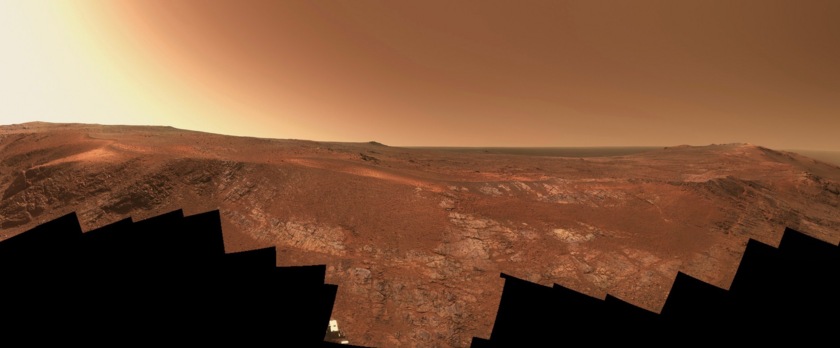
NASA / JPL-Caltech / Cornell / ASU / J. Sorenson
Rocheport Pan
Opportunity acquired the Pancam frames for the panorama above from the inside edge of the western rim of Endeavour Crater at Cape Tribulation on her Sols 4643–4654 (Feb.14–26, 2017). Mars image processor extraordinaire James Sorenson processed it in “true color.”The regional dust storm reported in the last MER Update sent gusts blowing eastward to Endeavour, which served to clear off some of the accumulated dust from Opportunity’s solar arrays and give her a boost in power. But as that storm began to dissipate at the end of February, another regional storm followed right behind it during the first sols or Martian days of March. That caused concern and ensured that dust would continue to command the skies in March.
By mid-month, the big dust storm of March also began to abate and the rover pressed on. Despite a previous prediction that 2017 may bring a planet-circling storm, the MER mission’s lucky star continued to shine and neither of those regional tempests to the west grew to shroud the planet.
Although Opportunity would feel the impact of all that haze in March, the golf-cart sized rover dodged two, potentially deadly dust bullets. “We are pleased that the dust storms have abated and the atmospheric opacity is coming down,” said MER Project Manager John Callas, of the Jet Propulsion Laboratory (JPL), birthplace of all NASA’s Mars rovers. But, he reminded, what goes up comes down.
And so dust rained steadily on Opportunity throughout March, cancelling out the boost in power she got in February. “The dust cleaning events didn't stick,” confirmed MER Power Team Lead Jennifer Herman, of JPL. “So far, we're dirtier now than we were before the storms.”
This ‘bot though has survived far worse and while she wound up driving a little less in March than the team would have liked, the rover that loves to rove kept on truckin’. Dirty perhaps, but she rambled on, seemingly still proud and apparently no worse for the wear after more than three months of hiking up the treacherous, rover challenging slopes of Cape Tribulation. As MER Chief of Rover Engineering Bill Nelson, of JPL, summed it up: “Opportunity is doing very well.”
The hazy, dust-filled sky and dirty arrays seemed to not matter a bit to this roving field geologist. “We still have plenty of power to continue marching on,” said MER Rover Planner Paolo Bellutta, a member of the technical staff of JPL’s renowned Robotics Division
Opportunity is actually still on the exterior or western slopes of Cape Tribulation and not quite on the Meridiani Plains yet, and so the drive distances have been largely limited by what the team members can see ahead. “We’re on rolling terrain and cannot drive into local lows where we cannot see what’s ahead,” Arvidson explained.

Peter Theisinger
Pete Theisinger, who led the projects that developed Spirit and Opportunity and Curiosity and successfully landed them on Mars, received the 2017 National Air and Space Museum Trophy for Lifetime Achievement on March 29th at the Smithsonian museum in Washington D.C. ““He set the tone from the beginning of this project,” said MER Principal Investigator Steve Squyres.”The rolling topography limited drives to around 15 to 30 meters (49.21 to 98.42 feet) in March and was, “the main limiting factor,” elaborated Bellutta, who computed Opportunity’s extended mission route and the “express route” she’s now traveling. “But we are making good progress.”
In a perfect Martian world, the scientists would like the rover to be at Cape Byron and the head of Perseverance Valley in June, Arvidson ventured, so the rover can spend some quality time working before the Martian winter arrives in Mars’ southern hemisphere in November. Should push come to shove or should the science team decide they see something they absolutely, positively must investigate along the way, Opportunity needs to be there no later than September, according to Herman.
That way, the ‘bot will have the time needed to scope out north-facing slopes where she can position herself toward the Sun during the mission’s eighth Martian winter. As Squyres, who never predicts the future, put it: “We're going to try and get there as fast as we can.”
Meanwhile on Earth, Opportunity roved into the spotlight once again at the Lunar and Planetary Science Conference (LPSC) that was held from March 20th through the 24th in The Woodlands, Texas. During the annual gathering, the rover “starred” in about a dozen presentations and posters covering everything from then, now, and when, or past, present and future.
Since landing in 2004, Spirit and Opportunity, together, have sent massive amounts of data and thousands of images home, enough to keep scientists busy for years, maybe decades to come. As a result, the MER mission has figured prominently in every LPSC gathering for the last 14 years, almost always drawing standing room only crowds.
This year, after Arvidson completed his presentation, he was asked if the MER team expected to rove on to Iazu Crater to the south of Endeavour sometime in the future. The mission’s Deputy Principal Investigator said what most MERsters say: “Do not bet against this rover.”
In other MER news, Pete Theisinger, who led the project that developed and built Spirit and Opportunity and who served as the mission’s first project manager at JPL, was honored March 29th with the 2017 National Air and Space Museum Trophy for Lifetime Achievement in a ceremony at the Smithsonian museum in Washington D.C.
Since 2000, when MER was but a concept on a Power Point, the mission has become legendary for so many reasons. From those magical moments when against all odds Spirit and Opportunity bounced to breathtaking landings in January 2004, through all the discoveries of past water and potentially habitable locations for life, and all the jaw-dropping roving records that have pushed the bar way up there for future ‘bots and transformed MER into the first overland expedition of Mars, there has been an almost uncanny, certainly rare camaraderie between the science and engineering teams.
By all accounts, Theisinger’s leadership and his first prime directive to the original MER team, along with Squyres’ charismatic commanding, are the key reasons why this mission has driven again and again into the hallowed halls of space exploration history. “I give a lot of the credit especially for the camaraderie between science and engineering to Pete Theisinger,” said Squyres. “He set the tone from the beginning of this project. On Day One, he said: 'Look, if all we do is land these things safely, we've done nothing. We score no points for that. It's been done.’”
Spirit and Opportunity, you may remember, were the follow-on rovers to Pathfinder’s little Sojourner, and their objectives revolved around the science. “Pete set the tone from the start, among the whole JPL team, that we were doing this [mission] to do good science on Mars,” said Squyres. “And people embraced that.”
Currently special assistant to JPL Director Michael M. Watkins, Theisinger has been “traveling” to Mars since Mariner 9 in 1971, and has worked on missions to six planets since joining JPL in 1967, and also led the Mars Science Laboratory/Curiosity project.
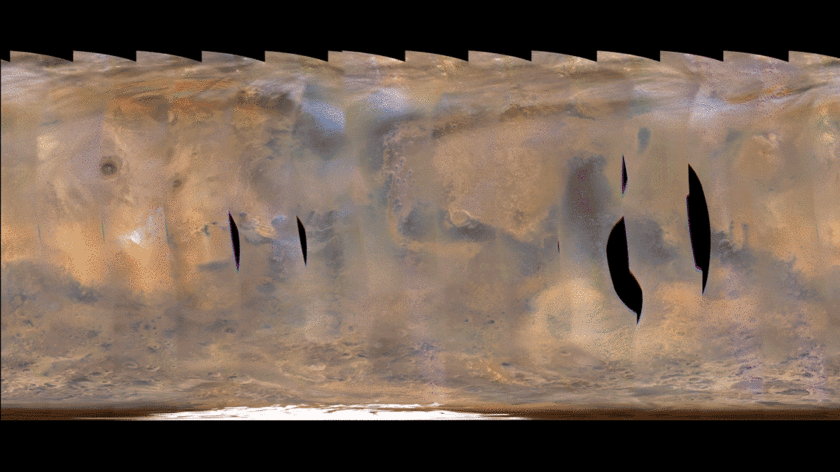
NASA / JPL-Caltech / Malin Space Science Systems
Back to back dust storms
Opportunity dodged a couple of dust “bullets” in the form of regional storms in February and March 2017. The second big storm spun up in during the first days of March and followed unusually closely to one that bloomed in February. This animation, created from images taken by the Mars Reconnaissance Orbiter’s wide-angle Mars Color Imager (MARCI), shows the second dust storm swelling and the first one dissipating. Sky observations at multiple lighting angles can provide information about changes in the size distribution of suspended dust particles as additional dust is lifted into the sky and larger particles drop more quickly than smaller ones. "We'll keep studying this for weeks as the dust clears from the sky," said atmospheric scientist Mark Lemmon, of Texas A&M University. Weekly Martian weather reports are available here.When March dawned at Endeavour, Opportunity had just completed the last of her science investigations inside the crater rim at Cape Tribulation. Because of constrained data volume, the rover eased into the month on Sol 4658 (March 1, 2017) spending the sol making atmospheric observations.
But on Sol 4659 (March 2, 2017), Opportunity climbed 12.9 meters (42.32 feet) to the west, and exited the crater rim. Then, the robot field geologist stopped to look around and take the routine Navigation Camera (Navcam) and Panoramic Camera (Pancam) images so the rover planners could chart the next drive and the scientists could document the site and take in the view.
The MER team on Earth actually spent those two first two sols of March in the annual two-day meeting at Caltech in Pasadena, California. There, team members discussed a little bit of everything, but focused mostly on the future. One topic of discussion was what to call the ancient gully. “We debated the name for about an hour,” said Squyres. The team members settled on Perseverance pretty quickly “because of the fact that we persevered so long to get there,” Arvidson said.
But Perseverance what? They considered Perseverance Gulch, Perseverance Ravine, Perseverance Gorge, and Perseverance Valley. Perseverance Gully was nixed because, “it does not capture the really ancient character of this gully,” said Squyres. “And that's an important aspect.”
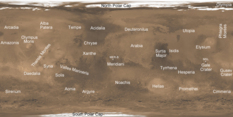
Mars Weather Reports Reference Map
Both of the two regional storms that darkened Opportunity’s doorstep in February and March 2017 grew in the Acidalia area of northern Mars, then blew southward, exploding to sizes larger than the United States after reaching the planet’s southern hemisphere around the area marked Xanthe in the above image. Personnel from the Malin Space Science Systems (MSSS) processed and labeled this image.NASA / JPL-Caltech / MSSS
The assumption going in is that this geological feature dates to the Noachian Period just like Endeavour, and therefore is no less than 3 billion years old and maybe older. “It has some impact craters superimposed upon it, so this thing is really, really old,” Arvidson pointed out.
Since this ancient gully is a valley system that runs downslope for about 200 meters in the Cape Byron segment of Endeavour’s rim, despite a spirited debate, the MER team members, after two votes, chose to nickname it Perseverance Valley. They also decided that since Opportunity had left the inner slopes of Cape Tribulation forever, it was time to put the Corps of Discovery / Lewis and Clark naming theme in the rear view mirror too.
“The naming theme we're using now is stops along the Transcontinental Railroad,” informed Squyres. There was a kind of sciengineering logic to that decision. “We chose that theme to make the point that we are booking, just like we're on rails, going south as fast as we can go,” he explained.
It remains to be seen how many targets between Cape Tribulation and Cape Byron will be named though considering that the rover is, metaphorically, on “rails” and there are no targets in particular the scientists are ‘dying’ to stop and investigate. Of course, Opportunity’s targets of opportunity and the pit stops already charted on her extended mission route will be christened as the rover rumbles toward Perseverance Valley.
On Mars, March motored on and so did Opportunity. The rover drove 30 meters (98.42 feet) in her first drive to the south toward the mission’s next big attraction on Sol 4660 (March 3, 2017). The next sol, the ‘bot took an atmospheric measurement of argon with her Alpha Particle X-ray Spectrometer (APXS), for the ongoing, mission-long study of the Martian atmosphere, as well as the usual images of her surroundings.
The large regional dust storm to the west of Opportunity’s site at Endeavour, which the MER team had been watching closely in February, was gradually abating. That was good news. But then, another squall appeared and chased the first storm, growing over Xanthe Terra to also become a regional storm. And the haze just kept on coming Opportunity’s way.
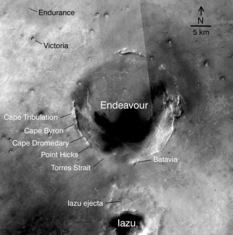
Endeavour Crater
The above image shows Endeavour Crater and points of recent interest for Opportunity and the MER mission. The rover recently departed Cape Tribulation and is en route now to Cape Byron and Perseverance Valley, an ancient gully likely more than 3 billion years old. The base image for the map is a mosaic of images taken by the Context Camera, operated by Malin Space Science Systems onboard MRO.NASA /JPL-Caltech / MSSS
Images from the wide-angle Mars Color Imager (MARCI) onboard the Mars Reconnaissance Orbiter (MRO) showed that each of these two storms developed in the Acidalia area of northern Mars. Then, they blew southward and grew to sizes larger than the continental United States after blustering into the southern hemisphere of the planet where Opportunity is roving.
The MARCI weather reports have become an incredibly valuable asset to the MER mission during the Martian spring and summer seasons, serving to not only warn the team, but enable the ops crew to take measures to protect Opportunity. But Mars is, well – Mars, and once again the Red Planet proved just how unpredictable it can be.
"We've had orbiters watching weather patterns on Mars continuously for nearly two decades now, and many patterns are getting predictable, but just when we think we have Mars figured out, it throws us another surprise,” said Mars meteorologist Bruce Cantor, of Malin Space Science Systems, San Diego, which built and operates MARCI.
While the development path from the Acidalia area southward is a common pattern for generating regional dust storms during spring and summer season in the planet’s southern hemisphere, this second regional dust storm right on the heels of the first one was unusual. Cantor reported the second of the back-to-back regional storms to the MER team on March 5th.
With the high-altitude haze from the first duster still clouding the skies, the second storm had team members and the MARCI crew wondering if this could go global. Although every previously observed planet-encircling dust storm on Mars occurred earlier in the southern summer, "[t]here's still a chance the second one could become a planet-encircling storm," Cantor said then. “But,” he added, “it's unlikely because we're getting so late in the season.”
Cantor’s assessment would prove to be, fortunately, a prescient statement, as well as an informed one.
Opportunity, for her part, was robotically undaunted. She was still producing more than 440 watt-hours of power and sporting a solar array dust factor of 0.770 (meaning that 77% of the sunlight beaming onto her solar panels was penetrating to the solar cells to make electricity). But the bad news was that the atmospheric opacity or Tau, as the team calls this measurement, was 1.660, where only 19% of direct sunlight was hitting the ground.
For the rover, that meant it was like “a somewhat worse than usual day in Beijing,” as Nelson put it. And she was starting to take on the dust that was raining down from the first big storm. Before then, “Opportunity’s solar panels were cleaner than they were during the last four Martian summers, so the panels generated more energy," noted Herman then.
But the second regional storm, along with all the raining dust would soon change that. It wouldn’t change the plan for Opportunity, not at this juncture anyway.

NASA / JPL-Caltech / Cornell / ASU / S. Atkinson
On the road to Perseverance Valley
Opportunity took the frames that went into this view in mid-March 2017 with her Panoramic Camera (Pancam) as she was heading south to Cape Byron and Perseverance Valley. From those frames, author, astronomy outreach educator, and MER poet, Stuart Atkinson, processed this painting-like image.Perseverance Valley was too important and time was of the essence. The rover kept on keepin’ on, chugging through the dusty fog and putting another 28.7 meters (94.16 feet) behind her on Sol 4663 (March 6, 2017). And then, as usual, she took extensive Navcam and Pancam images.
Opportunity drove into the second week of March on Sol 4665 (March 8, 2017), heading southeast and logging 21 meters (68.89 feet). Following the scientific protocol, the rover spent the rest of that sol and much of the next taking those ‘picture postcards’ that “have made Mars a familiar neighbor,” as Callas has so often put it.
The team had hoped the veteran robot field geologist would be able to drive that coming weekend. A combination of things however, including imaging data arriving too late for the rover planners to make immediate use of it, as well as the dusty skies and lower power, dashed that hope and limited the weekend's activity to remote sensing.
But when the going gets tough, the tough get going, and Opportunity has MER mettle. The rover took off again on Sol 4670 (March 13, 2017), heading south for 36 meters (118.11 feet). Not surprisingly and as the MER ops team expected, the ‘bot’s energy was beginning to drop.
Opportunity was feeling the effects of the dust shower caused by the first storm and it was impacting her ability to keep the pace. By Sol 4671 (March 15, 2017), she was producing 366 watt-hours, a fairly significant drop in a relatively short period of time, and her dust factor had deteriorated to 0.653, while the Tau rose slightly 1.692.
“It was enough to impact operations, but Opportunity’s power was still well above anything concerning at that point,” said Nelson.
As the third week of March took hold though, good news was blowing in the winds of Mars. The second regional dust storm that had been lingering above Xanthe Terra started to subside. Even so, as everyone on the MER team knew, the not-so-good news was just around the corner.
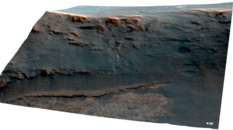
Destination: Perseverance Valley
Opportunity’s next major science attraction is Perseverance Valley, an ancient gully, clearly visible, just left of center in this image taken by the HiRISE Camera onboard MRO, likely dating to the Noachian Period 3 to 4 billion years ago. This view was processed in false color and then stretched (2X VE) so the MER scientists can better see the feature and the channels that appear to emanate from it.NASA / JPL-Caltech / UA
It was just a matter of time before all the dust that the second storm whipped high into the atmosphere would join the dust raining down from the first storm. And like a magnet a good amount of it would find the little robot.
On Sol 4672 (March 16, 2017), the rover pushed on to the south and managed to add 43 meters (141.07 feet) to her odometer. Given the super hazy skies, it was impressive actually. But on the next sol, the rover had to rest and recharge, in order to restore her batteries.
The team was hoping Opportunity would keep that pace during the forthcoming 3-sol weekend plan, but that was not to be. The robot’s power was lower than needed for everything the team wanted its ‘bot to accomplish. In fact, the tight energy constraints caused the rover planners to postpone a couple of drives and command their field geologist to stay put. The rover wound up spending what work time she had imaging on the first sol, and then chilling and recharging the second two sols.
Then, on Earth, the MER ops engineers discovered “a subtlety,” as the JPL Mission Reports described it, in the power model and that shed new light on the restricted power levels. Turned out, the model was not properly accounting for Opportunity’s quiet time. Rather, it was ‘thinking’ the rover was active and consuming more energy than she really was. So her low energy was actually “a predict problem and not a real rover problem,” said Nelson.
“It was just a bad combination of events on the Earth and on Mars,” said Herman. “Whenever the environment changes on Mars, the power model is programmed to adjust, but it's not perfect.”
Dust storm clouds or haze not only make the sky darker or more opaque, they also make it colder, because they block some of the sunlight from streaming down in the morning. And, the amount of energy in the battery is partially dependent on its temperature. “In this case, the model overcompensated and predicted that the battery temperature was colder than it actually was,” Herman said. “That made it more difficult for the planning team to get the science activities in, because their modeling tools kept showing that there wasn't enough energy when actually there was.”
Nothing is simple on Mars, and while there were a couple of other contributing factors, basically the storm did cause the rover’s energy to drop. It’s just that the model showed it had decreased more than it actually did. At the end of the sol, the software for the power model just needed to be tuned. Once Herman took care of that task, the model and the rover’s power levels were back in sync.
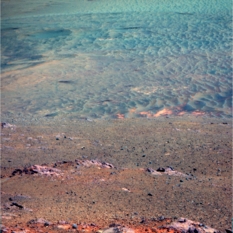
Roving on
Opportunity used her Pancam to take this view, on Mar. 28, 2017 as she roved along the outside of the rim of Endeavour Crater and toward Cape Byron and Perseverance Valley. The rippled, wave-like features are the floor of the crater. The Pancam team processed this image in false color, a technique scientists use to better discern the different geological elements in a given scene.NASA / JPL-Caltech / Cornell / ASU
The upshot was all good news. By Sol 4677 (March 21, 2017), Opportunity’s power was 423 watt-hours and her dust factor was estimated to be 0.615. Better still, the sky overhead was clearing a bit and the Tau had dropped to 1.181. The rover nonchalantly sauntered on.
Heading south, Opportunity logged 19.23 meters (63.09 feet) and two sols later, 4679 (March 23, 2017), she drove for 30.74 meters (100.85 feet), stopping after each drive of course to take the usual Navcam and Pancam images, and to rest and recharge.
The robot field geologist drove again on Sol 4682 (March 26, 2017) completing 14.76 meters (48.42 feet) and was slated to drive again the next sol, but didn’t. “We really wanted to, but we couldn’t get the drive direction images down,” said Nelson. “They got lost in transit between the Odyssey orbiter and the ground.” Instead, the mission stood down and the rover spent that sol retaking the images and downlinking them to Earth through the orbiter.
This time the images streamed into JPL in fine form and on Sol 4686 (March 30, 2017) Opportunity revved her ‘engine’ and put 38.79 meters (127.26 feet) in the rear view mirror. It would be the last drive of the month and it brought her odometer to 44,309.64 meters (about 44.31 kilometers or 27.53 miles). Despite all the dust and the power issue, the rover managed to drive 280 meters (918.63 feet) in March. Perseverance Valley was now less than 450 meters or a little more than a quarter mile away and the sky was looking a little brighter.
As March came to an end, Opportunity was producing a respectable 445 watt-hours, almost half her full capability after landing in 2004 with sparkling clear solar arrays. Her dust factor, not unexpectedly, was a little worse, estimated at about 0.604, and the Tau, recorded at 1.011, was a little better.
Something to keep in mind though is that the rover’s dust factor does tend to fluctuate a bit and not all of that fluctuation is necessarily be real. “We can't measure everything with total accuracy, although we can and do measure total energy we get for the day,” said Nelson. “We usually take a single Tau measurement per sol and assume the rest of the day is the same. But there is always a possibility that a dust cloud or ice cloud was in the way when we took that Tau and we get a lower measurement than what it is for the rest of the day,” he pointed out.
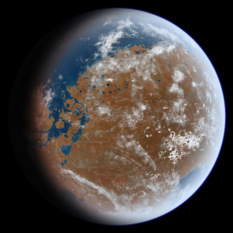
Noachian Mars
Could ancient Mars have looked like this? The image above is an artist's impression of an early wet Mars. Note that Late Hesperian Period features (outflow channels) are shown, so this does not present an accurate picture of Noachian Period Mars, but the overall appearance of the planet from space may have been similar. In particular, note the presence of a large ocean in the northern hemisphere (upper left) and a sea covering Hellas Planitia (lower right). The artist based this work on data from the Mars Orbiter Laser Altimeter (MOLA) one of the five instruments onboard the Mars Global Surveyor.Ittiz, Wikimedia Creative Commons
If that's the case, the engineers adjust the dust factor to reconcile the power measurement. “We take whatever the Tau is as gospel, and then we adjust dust factor to make energy the same,” Nelson explained. “So, even though the measurement is called the dust factor because that is the primary thing that's in there, this measurement contains all of the tolerances and other losses, like aging on the solar cells, or reflection or blocking from terrain that's not modeled and so forth. All those get factored in as if it were dust.”
This much is certain however: the dust will continue to rain down for some time. Since the winds that cleared the rover’s solar arrays in February had blown up from the crater as they do, the MER ops engineers and scientists aren’t anticipating any cleaning events as the robot boogies down to Cape Byron.
“We're a little far away from the edge of the crater to have any dust cleaning,” Nelson noted. “And we’re liable to see the dust building up a little faster than usual for a while. Even so it's now only accumulating 1/10th of one percent or less per sol on average. We've certainly been a lot worse.”
Despite it all, Opportunity pressed on, trooper that she is and always has been. “You know, gee, I'm running out of words,” said Callas. “We're making good progress and are on trend toward Perseverance Valley and the rover is doing well.”
And that, along with continued cooperation from Mars, is really just what the mission needs right now.
Opportunity was slated to spend her first sol in April taking images of a light toned mesa just beyond beyond Perseverance Valley that the team dubbed Winnemucca, after the railroad station in Nevada. No foolin’. The plan past that is, as Arvidson put it: “Drive, drive, drive.”
The Time is Now.
As a Planetary Defender, you’re part of our mission to decrease the risk of Earth being hit by an asteroid or comet.
Donate Today

 Explore Worlds
Explore Worlds Find Life
Find Life Defend Earth
Defend Earth


